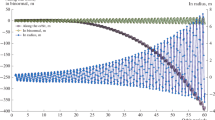Abstract
The necessary conditions for the implementation of information technology, which ensure the autonomy of operation while improving the accuracy of the ephemerides and clocks of the existing midaltitude segment of GLONASS, are substantiated. The discussed technology includes methods and algorithms for improving the accuracy of forecasting and refining the ephemerides of navigation spacecraft (NSC) in an inertial coordinate system, predicting and refining the evolution of the Earth’s rotation parameters, and precise synchronization of onboard clocks. Attention is paid to creation of the necessary conditions for the implementation of the first of these components of the proposed technology, which provides prediction and refinement of the ephemerides in an inertial coordinate system, including in the autonomous mode of satellite constellations. The component is implemented in the form of a block of special procedures for using equipment for measuring distances between satellites. In this case, a number of technical problems and related limitations arise that prevent the successful use of such equipment in solving the problem of NSC ephemerides refinement. The approaches and methods proposed by the authors, which are designed to overcome some of the problems and limitations and, ultimately, to improve the accuracy of the formed estimates of NSC ephemerides based on processing the intersatellite measurements formed using the onboard hardware, are described.


Similar content being viewed by others
REFERENCES
D. M. Kruzhkov and V. V. Pasynkov, National Global Navigation Satellite System GLONASS: Features of Creation, Development and Use (Moscow Aviation Institute, Moscow, 2022).
https://glonass-iac.ru/glonass/technical. Accessed March 13, 2022.
M. N. Krasil’shchikov and D. M. Kruzhkov, “On the issue of autonomous refining of the Earth orientation parameters onboard spacecraft. analysis of the possibilities of developed information technology,” Cosmic Res. 59 (5), 357–365 (2021).
A. K. Grechkoseev, “Study of observability of motion of an orbital group of navigation space system using intersatellite range measurements. I,” J. Comput. Syst. Sci. Int. 50 (2), 293–308 (2011).
A. K. Grechkoseev, “Study of observability of motion of an orbital group of navigation space system using intersatellite range measurements. II,” J. Comput. Syst. Sci. Int. 50 (3), 472–482 (2011).
SVOEVP. https://glonass-svoevi.ru/. Accessed December 10, 2022.
Author information
Authors and Affiliations
Corresponding author
Additional information
Publisher’s Note.
Pleiades Publishing remains neutral with regard to jurisdictional claims in published maps and institutional affiliations.
Rights and permissions
About this article
Cite this article
Krasil’schikov, M.N., Kruzhkov, D.M. & Pasynkov, V.V. On the Implementation of Information Technology for Refining the Ephemerides of GLONASS Spacecraft Based on the Use of Advanced Intersatellite Measurement Hardware. J. Comput. Syst. Sci. Int. 62, 627–635 (2023). https://doi.org/10.1134/S1064230723040093
Received:
Revised:
Accepted:
Published:
Issue Date:
DOI: https://doi.org/10.1134/S1064230723040093




